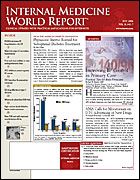Publication
Article
Internal Medicine World Report
Uterine Fibroid Embolization for Postmenopausal Women
Author(s):
From The Society Of Interventional Radiology
TORONTO, Canada?Nonsurgical uterine fibroid embolization (UFE) appears to be a viable treatment option in carefully selected postmenopausal women with pressure- and size-related symptoms of fibroids. The procedure should be considered as an alternative to hysterectomy in women in whom magnetic resonance imaging has excluded other pelvic pathology, according to data presented at the Society of Interventional Radiology's 31st Annual Scientific Meeting.
This first study of UFE in postmenopausal women included 24 participants (age, 43-61 years) who were all identified as being postmenopausal.
At an average follow-up of 9 months, the treatment was deemed technically successful in 100% of cases and improved bulk-related symptoms in 92% of them; a 36% reduction was seen in mean uterine volume and a 42% reduction in the dominant fibroid.
"Although uterine fibroids generally regress after menopause due to the change in hormone levels, many postmenopausal women continue to suffer pain, constipation, urinary frequency, and other symptoms caused by their fibroids," said investigator Robert Vogelzang, MD, chief of vascular and interventional radiology, Northwestern University School of Medicine, Chicago. "This research shows that nonsurgical uterine fibroid embolization effectively reduced fibroid-related symptoms in postmenopausal women and should therefore be offered as a treatment choice."
UFE has been performed by interventional radiologists since 1995 to treat symptomatic noncancerous tumors of the uterus.
IMWR
"We are expanding the indications for an already extremely effective technique. Until now it was thought that postmenopausal women would do fine with conservative management. We found that in women with bulk, that is, pressure- and size-related symptoms, the uterine fibroid embolization was as effective as in premenopausal women. The number of women responding in this study was a bit higher," Dr Vogelzang told .
He believes that primary care physicians should add UFE to the list of treatments to recommend, along with hysterectomy and myomectomy, in this patient population.
An estimated 20% to 40% of women aged ≥35 years have uterine fibroids of a significant size. Among black women, as many as 50% of those aged ≥35 years have significant fibroids.
Dr Vogelzang noted that uterine fibroids are the most frequent indication for hysterectomy in premenopausal women in the United States, accounting for one third of the 600,000 hysterectomies performed annually. "I think primary care physicians need to hear about this technique," he said.






